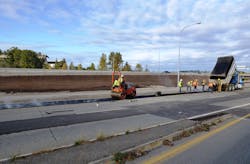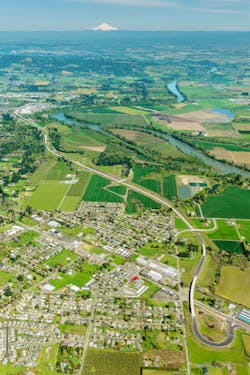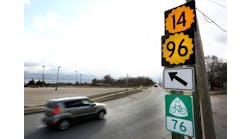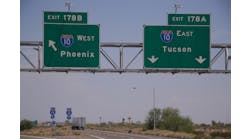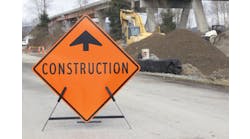By: Brian W. Budzynski, Bill Wilson and Tim Bruns
CALIFORNIA:
At the forefront
by Brian W. Budzynski, Managing Editor
There’s progress and then there’s progress, and those who know the difference can only be encouraged by some of the developments taking place in California.
As a result of the recent 12-cents-per-gallon gas tax increase passed by the state legislature, the California Department of Transportation (Caltrans) has accelerated several dozen projects statewide, totaling just under $1 billion in existing or planned work, in anticipation of receiving the flood of new funds.
The tax hike is expected to raise roughly $5.4 billion annually over the next decade. About half of the money will go to the state to improve highways, bridges and culverts. The other half will go to cities, counties and transit agencies for local street and road repairs, and improving public transit options. There also is some money earmarked for congestion relief, bicycle and pedestrian infrastructure, transportation research, workforce training and planning efforts.
At a time when echoes of a federal gas-tax boost can be heard out of Washington, D.C., (along with the lash of commensurate detractors), California’s measure reads like an act of rebellion against conservativism. According to Caltrans Assets Manager Michael Johnson, the added dollars will set the stage for both the continuation of the state’s already successful bridge program and an aggressive campaign to address its rural roads problem, which is among the worst in the U.S.
“Between 2005 and now,” Johnson told Roads & Bridges, “the number of bridges recommended for rehabilitation has been cut in half. We attribute that to our aggressive preservation approach. Looking forward, the tax law has a $400 million-per-year dedicated fund for bridges and culverts that are in fair or poor condition. What we want is to get that 4% down to 1.5% within the next 10 years. We will use a lot of these funds to knock out a whole lot of rehabs and replacements that still need to be done.”
According to FHWA data, the state has one of the best bridge inventories in the nation, with only 4% of its bridges considered to be “poor” and more than 65% classified as “good” or better. Yet its road safety record, notably for rural roads, is among the worst. For now.
“Our pavement need is about $1.4 billion per year, but until the passing of this new state law, we only had about $900 million,” Johnson said, “so significant progress will be made on the roads side as well. This new tax effectively doubled funding for city and county roads and bridges.”
Driverless developments
Another progressive development concerns allowing autonomous vehicles to live-test on state roads sans human intervention, which it looks like may happen as of June 2018. The state’s Department of Motor Vehicles has proposed a new set of streamlined regulations that would remove the requirement of having a live driver in the AV during operation, much as Arizona and Florida have already done. The new regulations would require that manufacturers testing driverless cars on public state roads certify that they are meeting federal standards and that any public paperwork shared with federal regulators on driverless testing also is passed to the DMV. Currently, there are nearly 300 self-driving cars being tested on state roadways, and that number is expected to grow exponentially, should these new regs meet final approval.
“We’re definitely excited about autonomous vehicles,” Johnson said, “from both a safety perspective and a traffic congestion management perspective. We’re ready to adapt the infrastructure. We’ve already begun thicker lane markings through the state, for AVs to read.”
The state is already home to one of the 10 federally sanctioned autonomous vehicle testing proving grounds in the U.S. in Contra Costa County’s GoMentum Station, which has recently announced partnerships with Sumimoto Electric, First Transit, Otto, EasyMile and Honda, among others.
----------------
The state of Washington’s latest road-funding package, Connecting Washington, will supply just over $16 billion of work on roads and bridges. Image: WSDOT
WASHINGTON:
Full of activity
by Bill Wilson, Editorial Director
The state of Washington prefers its gas stations to be self serving. When the federal government continues to fail when it comes to funding, what else are you supposed to do?
There have been three gas tax increases in Washington State since 2003, and the latest one, passed in 2015, will generate about $16.1 billion behind an 11.9-cent-per-gallon jump.
“[Lawmakers] have been very receptive to the discussions and moving [the increases] forward,” Lars Erickson, spokesman for the Washington State DOT told Roads & Bridges, “but obviously that came with considerable debate, so there are probably some people here that would say they were not very receptive.”
Debates have ultimately gone one way—in favor of transportation. The 2003 tax, called the Nickel Funding Package, raised the gas fee 5 cents and generated $3.9 billion, while 2005’s Transportation Partnership Program called for a 9.5-cent-per-gal increase and created $7.1 billion. The contents of the latest package, Connecting Washington, are the most valuable—$16.1 billion behind an 11.9-cent-per-gal increase. Several projects, including the Alaska Way Viaduct and the 520 Corridor, were funded behind the first two boosts, while the current one will father more impactful projects like the North Spokane Corridor.
After some initial bumps with its massive tunnel boring machine, the Alaska Way Viaduct project has found its groove. The contractor is currently working on the roadway structures inside the tunnel as well as the mechanical elements of the project. The latest schedule has it opening up in early 2019.
The centerpiece of the 520 Corridor Project, a floating bridge, is now carrying traffic, but overall work continues. The connection from I-405 to Lake Washington is finished, and currently the focus is on the west side where crews will reach I-5 in Seattle. Most of it involves bridge work over Mott Lake and Portage Bay. According to Erickson, the project should be completed in 2018.
Connecting Washington is already ripping pages out of WSDOT’s backlog book. The Gateway Project in the Seattle area takes care of two jobs that have been on the agency’s books for quite some time. Work on SR 167 will provide a connection to the Port of Tacoma, and SR 509 will link to I-5. The early planning phases were under way at press time.
“[The SR 167 job] is really a freight improvement project that will help get goods coming into the port into the area of the region where a lot of distribution happens, so it will be a huge help for the freight industry,” said Erickson.
The U.S. 396 North Spokane Corridor project also will happen in the near future after Connecting Washington fully funded the $879 million endeavor. When complete, motorists will be allowed to move north and south through the city of Spokane, from I-90 to U.S. 395 in Wandermere.
WSDOT also is willing to have another go at the I-5 Bridge that connects the states of Washington and Oregon. One of the existing spans just turned 100 years old, and the seismic vulnerability of both structures is high. Plans to build a new bridge have been scraped a couple of times because the two states could not come up with a way to fund the plan.
“We have been directed as an agency to evaluate the work that was done on the previous project that was shuttered and be ready to engage in another broader discussion,” said Erickson.
Washington is one of a handful of states in the blue according to the Roads & Bridges’ 2017 Bridge Inventory map, with just 4% of bridges rated as “poor.” Erickson hopes future funding can continue to address more maintenance/preservation projects.
----------------
An aerial view of the Newberg-Dundee Bypass project in Yamhill County, Ore. Image: ODOT
OREGON:
In good shape
by Tim Bruns, Associate Editor
Things are looking pretty bright for the Oregon Department of Transportation (ODOT) as state lawmakers passed a transportation funding act this July that will significantly increase investment in the state’s roads and bridges.
Dubbed “Keep Oregon Moving,” the passage of HB 2017 is expected to nearly double both the bridge program and the pavement preservation program for ODOT with the introduction of a 10-cent gas tax increase in the state. The new legislation will benefit local transportation agencies as well.
“The interesting thing about highway funding in Oregon is it’s required by state statute that if funding increases to the state highway department, a similar increase has to go to the local agencies,” Bruce Johnson, ODOT state bridge engineer, told Roads & Bridges. “So basically 50% of the increase in funding goes to state and 50% goes to locals.” From the total funding increase, 30% will go to Oregon’s counties while 20% will go to the cities.
The gas tax increase is the first to be implemented in the state in nearly three decades, and comes at a time when the extent of recent work on most of the state’s bridges has been repair or rehabilitation. “We haven’t been systematically renewing our inventory due mostly to really low funding in the bridge program for the last 30 years,” Johnson said. In addition, federal funding for Oregon has been basically flat.
With the new funding guaranteed by HB 2017, ODOT is gearing up for four major “high-visibility” projects dedicated to congestion relief and big bridge replacements. One is a seismic retrofitting and widening of the I-205 Willamette River bridge in an area that has been a bottleneck on a main interstate in the Portland metro area. The project also includes adding a third lane to the interstate for 10 miles.
Another major undertaking will be the I-5 Broadway Weidler project, which will consist of building tunnels over and widening 2 miles of I-5 in downtown Portland. Also in the same metro area, SH 17 will be getting a third lane for about 10 miles southbound. On this notoriously congested roadway, there are about six or seven major bridge crossings that need to be rebuilt for the widening.
The last of these major projects is the complete replacement of the Scottsburg Bridge in southern Oregon on SH 38, the main route from the I-5 Roseburg area to the coast. The area has suffered from significant congestion issues where the bridge goes over the Umpqua River.
According to a TRIP report from May 2017, only 5% of the state’s bridges were considered structurally deficient (SD). According to Johnson, that number is down to just under 2%. “Oregon is in pretty good shape, if you’re looking at structurally deficient,” he said. The low numbers for Oregon’s SD bridges in its inventory is partially attributed to the Oregon Transportation Investment Act (OTIA) from 2003, a 10-year program that targeted 350 deficient structures in the state for bridgework and analysis. Functionally obsolete bridges, however, have still been an issue for Oregon due to a lack of funding to address narrow and low-clearance bridges.
One unique factor for Oregon’s bridge inventory is that there are still many timber structures in the state. “We have probably at least a couple hundred left on the state system that we’re going to try to be targeting to more longer-life, durable kinds of bridges,” said Johnson.

